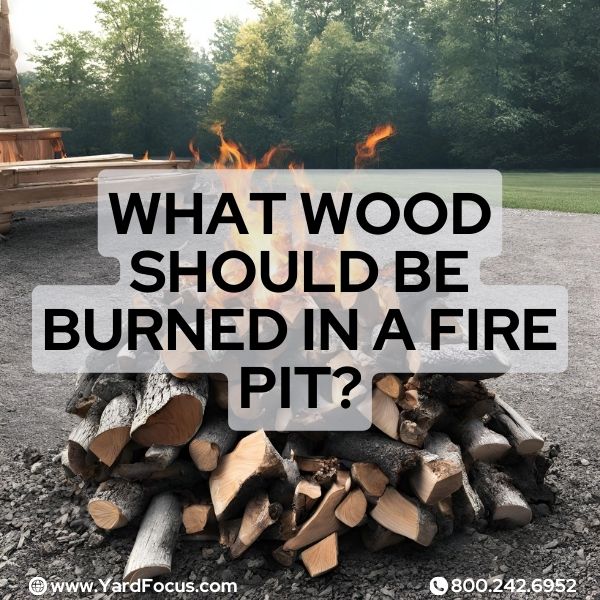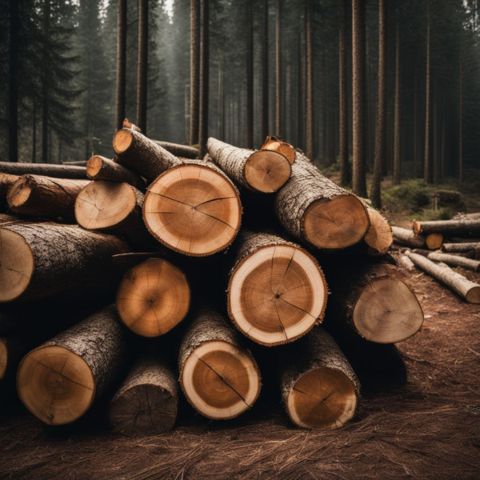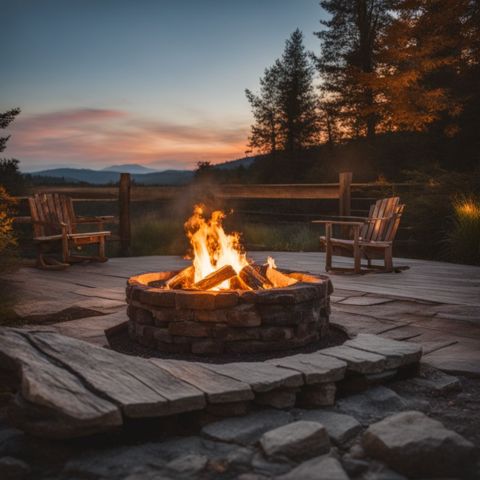
What Wood Should Be Burned In A Fire Pit?
Have you ever wondered what wood should be burned in a fire pit?
You've probably noticed an unpleasant smell or excess smoke when burning wood in your fire pit. Different woods burn differently.
This blog post guides you on selecting the right wood for a clean, efficient fire pit experience.
Enjoy cozy evenings around the fire pit with the proper fuel.
The Essentials of Fire Pit Wood
Fire pit wood must be seasoned properly. Seasoning removes moisture, allowing better combustion and less smoke.
Hardwoods like oak and maple burn hotter and longer than softwoods like pine.

However, some softwoods, like cedar, make excellent kindling due to their ability to ignite quickly, though they should be used cautiously because they can produce excessive smoke and sparks.
Seasoned Wood Explained
Seasoned wood has a moisture content between 15 and 20%. Optimal moisture content can vary, but generally should not exceed 20% for efficient burning.
This low moisture allows the wood to burn efficiently with minimal smoke. Properly seasoned firewood produces a hotter, cleaner flame.
Kiln-dried logs ensure consistent low moisture for optimal combustion.
Hardwoods like oak, maple, and ash are denser woods that season well for fire pits.
Softwoods, including pine and cedar, contain higher levels of resin, which can lead to increased smoke and creosote buildup, making them less suitable for prolonged burning in fire pits.
Avoiding green, unseasoned wood enhances fire pit performance.
Comparison: Hardwoods and Softwoods
Choosing the right type of wood for your fire pit is crucial for safety and enjoyment.
Hardwoods and softwoods differ in several ways, affecting how they burn. Below is a comparison to help you make an informed choice.
Hardwoods, such as oak, ash, apple, and beech, burn for a long time. This makes them perfect for nights around the fire pit.
They produce a lot of heat and burn cleanly. This means less smoke and fewer sparks.
Softwoods like pine and cedar catch fire quickly, making them excellent for initiating your fire.
However, due to their rapid burn rate and tendency to produce smoke, it's best to use them for kindling and start your fire with them before adding hardwoods to ensure a steadier, longer-lasting burn.
Your choice between hardwoods and softwoods depends on your fire pit needs. Use this guide to pick the right wood and enjoy your fire pit safely.
Optimal Wood Choices for Your Fire Pit
Fire pits thrive on seasoned hardwoods and softwoods. Seasoning removes moisture, enabling better burns.

Hardwoods like oak and maple provide long, hot flames. Softwoods like pine and fir offer lively kindling and vibrant sparks.
Top-Recommended Hardwoods
Hardwoods are the preferred choice for your fire pit. Here are some top recommendations:
- Oak: A dense wood that burns slowly and produces excellent heat. Oak logs are readily available and provide long-lasting fires.
- Maple: This wood has a pleasant aroma when burned. Maple logs generate a hot fire with minimal sparks.
- Ash: Ash is another excellent firewood option. It ignites easily, burns cleanly, and has a high heat output.
- Birch: Birch logs burn hot and bright, making them ideal for outdoor fires. The bark helps the wood catch fire quickly.
- Beech: A heavy hardwood that produces ample heat and long-burning coals. Beech has little smoke or sparks.
- Apple: Fruitwoods like apples offer a delightful scent when burned. Apple wood also generates good heat output.
- Hornbeam: Though less common, hornbeam is a superb firewood with a high heat value and minimal smoke production.
Due to their density and low moisture content, hardwoods such as oak and ash produce hotter, cleaner fires compared to softwoods.
It is advisable to use seasoned hardwood logs to achieve optimal combustion and minimize smoke.
Best-Performing Softwoods
Pine is a popular softwood for fire pits. It ignites quickly and burns hot. Cedar is another suitable option.
Softwoods that perform well in fire pits:
- Pine - Easily available and affordable and has a distinctive smell that might be appealing to some users, though it can also produce a considerable amount of smoke and pitch.
- Cedar - Known for its distinct, woodsy fragrance and ability to dry rapidly after rainfall, making it suitable for use as kindling in fire pits.
- Fir - Offers an even burn with moderate heat output, and it tends to produce fewer sparks and pops, making it a safer option for fire pits.
- Spruce - Clean-burning with a fresh, crisp scent. Seasoned spruce lights effortlessly.
- Hemlock - Inexpensive and readily accessible. Produces sustained warmth.
- Redwood - Ignites smoothly despite its density. Long, steady burn time.
- Cypress - Excellent for outdoor fires due to its heat retention capacity.
Types of Wood to Avoid
It is advisable to avoid burning wood with a high resin content in your fire pit.

While conifers like cedar and pine can be used for kindling, their high resin content can release excessive soot and sparks.
Steer clear of treated or painted wood. These woods release toxic fumes when burned. Stick to natural, untreated hardwoods and softwoods.
High Resin Content Woods
Softwoods like pine contain high resin levels. These resins create excessive smoke, sparks, and popping hazards when burned in a fire pit.
The incomplete combustion also releases unpleasant odors. Avoid using softwood logs or wood chips in your outdoor fire pit.
The Risks of Burning Treated or Painted Wood
Burning treated or painted wood poses significant risks. Treated wood often contains chemicals like chromium, copper, and arsenic compounds.
When burned, these substances release toxic fumes that are hazardous to human health.
Painted wood may contain lead-based paints, releasing lead particles into the air. Inhaling these pollutants can cause respiratory issues and potential poisoning.
Additionally, burning engineered wood products like plywood or particleboard emits harmful gases.
These materials often contain glues, resins, and fire retardants that produce dangerous fumes when combusted.
Maximizing Safety and Efficiency in Fire Pit Use
Proper wood storage prevents moisture buildup. Start fires with dry kindling and small sticks.

Monitor flames and ashes constantly during burning. Keep a fire extinguisher nearby.
Proper Wood Storage Techniques
Proper wood storage is crucial for efficient fire pit use.
- Store wood in a dry, well - ventilated area. Avoid ground contact.
- Cover the wood pile to protect it from rain and snow. Allow airflow.
- Stack wood in a crisscross pattern for maximum ventilation.
- Split large logs for quicker drying.
- Separate seasoned and unseasoned wood.
- Monitor moisture content regularly using a moisture meter.
- Rotate your wood supply to use the oldest wood first.
- Raise a wood pile on pallets or concrete blocks.
- Maintain a clear area around the wood pile.
- Check for pests like termites or carpenter ants.
Employing these techniques ensures your firewood is dry, pest-free, and ready for efficient, smoke-free fires.
Proper storage maximizes heat output while minimizing emissions.
The Role of Kindling in Starting a Fire
Kindling acts as a firestarter. Small twigs, dry leaves, and wood shavings make excellent kindling.
Proper kindling allows oxygen to flow, aiding combustion. Start with a small pile of kindling. Add more pieces gradually as the fire grows.
For optimal burning, use seasoned hardwood logs after establishing a base with kindling.
While softwoods like pine are effective for kindling due to their quick ignition, it is important to handle them with care as they are prone to producing excessive sparks, which can pose safety risks.
The next section covers the best log choices for a fire pit.
Effective Fire Monitoring Practices
Effective fire monitoring practices ensure a safe and controlled burn. Regularly check the flames and embers.
- Use fire tools like pokers and tongs to manage the blaze. Gently stir the coals and add more fuel as needed.
- Keep a water source nearby in case the fire spreads. A garden hose or bucket filled with water can extinguish errant sparks.
- Watch for flying ashes that could ignite dry leaves or grass. Clear the area around the fire pit before lighting.
- Avoid leaving the fire unattended. An adult should monitor the flames until they are fully extinguished.
- Let the ashes cool completely before disposing of them in a metal container. Never dump hot ashes in a trash can or near combustibles.
Careful oversight prevents dangerous situations and property damage. The next section discusses wood storage techniques.
FAQs
What types of wood should not be burned in a fire pit?
Pressure-treated wood, green wood, and wood containing poison ivy should not be burned, as they can release toxic fumes and cause safety hazards.
Is it safe to burn construction wood in a fire pit?
No, construction wood is often treated with chemicals and should not be burned in a fire pit as it can release harmful toxins.
What are some good options for wood fuel in a fire pit?
Kiln-dried logs, charcoal briquettes, and hardwoods like hickory or oak make good fuel choices for a fire pit.
Can I burn needles and cones from evergreen trees in my fire pit?
Needles and cones from trees, including Eastern Red Cedar, are highly flammable; however, their tendency to produce excessive smoke and sparks means they should generally be avoided in fire pits.
Are there any woods that can cause allergic reactions when burned?
Yes, burning oleander or other poisonous plants can release toxins that may trigger allergic reactions or respiratory issues.
Is it better to use softer or harder woods for outdoor cooking and grilling?
Harder, denser woods like oak or hickory are preferred for grilling and outdoor cooking, as softer woods can impart undesirable flavors.
Conclusion
Knowing what wood should be burned in a fire pit will help you choose the right wood fuel.
Hardwoods like oak, maple, and birch create long-lasting fires with minimal smoke. Pine and cedar ignite quickly, making ideal kindling.
Avoid unseasoned logs, treated woods, and softwoods with high resin content.
Properly stacking seasoned hardwoods and kindling promotes efficient combustion.
Follow safety guidelines, monitor the fire, and enjoy responsibly sourced, sustainable firewood.
